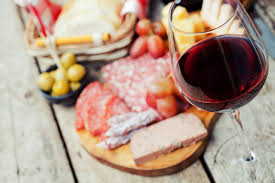Read Time:1 Minute, 43 Second
Charcuterie & Wine
Craig Campbell
Charcuterie & cheese are very popular items to have with wine, especially so during the heat of summer or early fall when one doesn’t necessarily want to cook over a stove or oven in near thirty degrees. Charcuterie also serves as a great sharing plate with friends over a social gathering or as a shared appetizer in a restaurant. It’s loosely defined as cured meat. It encompasses bacon, ham, salami, rillettes, paté, or sausage among other things. There’s a wide world of charcuterie out there. Whether it’s imported Prosciutto di Parma from Italy, or locally made sausage or jerky, it’s diverse and, frankly, yummy.
Â
A lot of cured meat has two characteristics in common: salt & fat. Again, yummy. So what’s a good wine to drink with charcuterie? Generally (and this applies to most anything) a crisp sparkling wine will match well with any cured meat. But, if sparkling isn’t your thing, try a lighter style white wine that’s not too oaked. (Hint: this means at least 85% of our locally made white wine is a safe bet.) If you prefer a red wine, I suggest a light red. While a full-bodied red like a Cabernet Sauvignon is great for a medium rare steak, it’s a bit tannic for most cured meats. Remember cured meats have flavouring agents, including spice. Spice clashes with high tannic wine. Yes, cured meat contains fat that usually works well with tannin, but one has to factor in the spice and curing of sausage and salami. Fortunately, in NS, we produce lighter reds that are better suited to charcuterie boards. A locally made Leon Millot would be magical. International reds matched well with charcuterie would include such things as Beaujolais from France or Barbera from Italy.
Â
Hey, it still feels like summer. Enjoy that extra time at the beach. A Charcuterie plate will save you from working over a hot stove. There’ll be plenty of time for that after October.
